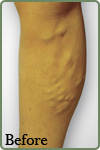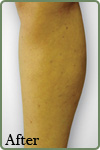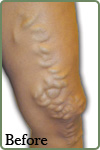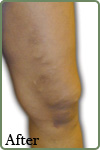What are Varicose Veins?
Healthy veins have one-way valves to ensure blood flows in one direction toward the heart. When valves fail or leak, the blood flows backwards causing blood to pool in the veins. The increased pressure from the pooling stretches the vein, causing enlarged, twisted blood vessels. This creates the bumpy, rope-like veins called varicose veins.
Symptoms
Often, the skin surrounding the varicose veins itches and burns. If left untreated, varicose veins can lead to swelling, fatigue, throbbing or cramping, increased pain, skin discoloration, and ulcerations of the lower legs. Ulcerations are difficult to treat and can become easily infected and painful. Many of these symptoms can be prevented by early treatment.
It normally takes years for symptoms of varicose veins to develop. While varicose veins are commonly inherited, anyone can get them. Hormonal changes brought on by puberty, pregnancy, and menopause can trigger the onset of varicose veins.
Diagnosis
Although varicosities are often glaringly evident, the root cause of the varicose veins may be more difficult to identify. However, treating the underlying cause of varicose veins helps ensure a more effective and durable result. Depending on the results of the screening examination, your doctor may recommend additional tests such as diagnostic ultrasound to identify where and how badly your veins are malfunctioning. The ultrasound examination evaluates the blood flow in your leg veins, and allows your doctor to localize the problem areas.
Treatment
Venacure EVLT™ (Endovenous Laser Treatment), the primary treatment for varicose veins, is a minimally invasive laser procedure. The in-office procedure does not require general anesthesia, takes less than an hour, and walking immediately after the procedure is encouraged. Normal daily activity can be resumed immediately; just avoid rigorous activities such as gym workouts. Your physician inserts a catheter into the vein and then inserts a thin laser fiber which emits light. By delivering the right wavelength of laser energy to the correct tissue, the malfunctioning veins (varicose veins) will close. Your body automatically routes the blood to other healthy veins, improving the circulation in your leg. Removing varicose veins normally takes less than an hour, requires only local anesthesia, and has up to a 98% success rate.
Ambulatory Phlebectomy is an alternative treatment option available for those suffering from certain forms of varicose veins. This treatment removes the bulging varicose veins through small incisions, using a local anesthesia, with minimal scarring and very little down time. Treatment can be used independently or in conjunction with EVLT (Endovenous Laser Treatment) depending on the severity and type of the venous disease.
For more information on what treatment is best for you, please call today for your free screening.




- Surgery involves considerable preparation, general anesthesia, the risk of infection, pain in the affected areas, and a lengthy recovery period. The medical laser technology used in EVLT eliminates all of that.
- EVLT is "minimally invasive." The laser enters through a tiny point the size of a freckle—there is no large incision and there are not stitches.
- There is no significant recovery time. In fact, you'll be up and walking as soon as the procedure is over. Most people return to normal activites the next day. You will be asked to wear compression stockings following the procedure.
- The risk of infection is extremely low.
I've heard about lasers being used in medicine but I'm not sure how they work. Are they safe?
Simply put, a laser is a highly concentrated beam of light. Medical lasers work by delivering this light energy to the targeted tissue with extreme precision so as not to affect the surrounding tissue. They've proven their safety and effectiveness through years of use in all kinds of medical procedures, from ophthalmology to dermatology. In the hands of a skilled physician, lasers offer far less risk and complications than conventional surgery.
How long after the procedure will I see the results?
There may be some slight swelling right after the procedure, but you could start seeing results immediately.
How long will the results last?
You should experience no reoccurence in the veins that have been treated. Follow-up procedures may be desired to obtain optimal aesthetic results.


 Healthy Valve Function
Healthy Valve Function Valve Failure
Valve Failure
